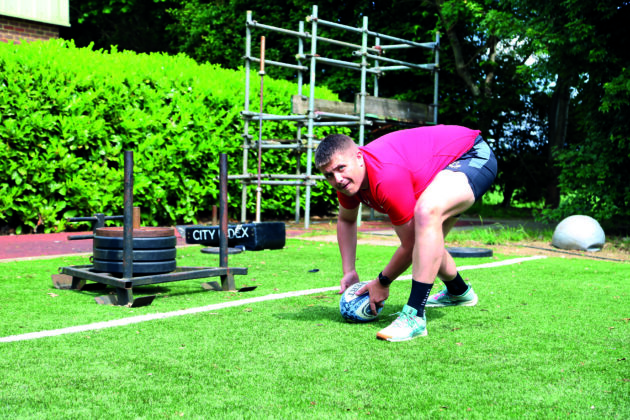Rugby World teamed up with Saracens to see just how good the pros are at lifting tin and whether an amateur could keep up…
Besides natural ability, a razor-like understanding of the game and years of unwavering dedication to the sport, one of the biggest points of difference that separates amateur and professional rugby players is strength and conditioning.
Stand next to a pro and you will quickly see just how big and fit they are. In fact, it is probably the biggest progression in rugby since professionalism 30 years ago. Gone are the players with a bit of a pot belly or chicken-wing arms. The henchest props are crushing Bronco tests in under five minutes while the slightest scrum-halves are bench-pressing 1.5 times their own bodyweight.
Related: Hardest men in amaetur rugby
It is this dedication to strength and conditioning that, in my view, has created the biggest gulf between the amateur and professional game. But just how big is the gap to us mere mortals? During a long and hot pre-season, myself and deputy editor Josh Graham were invited by nutrition experts Science in Sport (SiS) to the training ground of six-time English champions Saracens to see how we would fare in a standard gym session against some of the top professionals in English rugby.
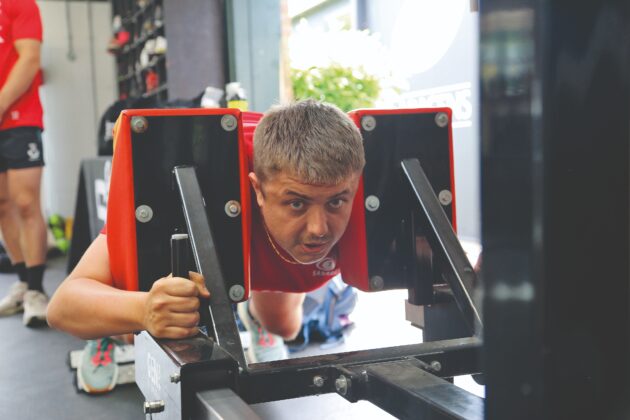
Rugby World Cup editor Joe Robinson in action (Cara Bowen)
To guide us through the session, we were joined by Saracens strength & conditioning coach Ben Calder and first-team players Rotimi Segun and Charlie Bracken. An agenda was set of three key functional strength exercises. “We’re going to set you three exercises that we routinely test our players at Saracens with. First is the dynamic bench press; this is the barbell in the bench-press position but with resistance bands attached to the ends,” explains Ben.
“They add more resistance the further you push away from the chest and it tests how dynamically you can push. Then we have CMJs which are counter movement jumps. This is three static jumps, hands on hips, to see how high you can get and the power you can generate in your legs.
“Then finally a three-rep max weight chin-up, which is what it says on the tin. All about your pulling power! These testing movements tend to be introduced when we’re working with players on strength and speed simultaneously, which is most of the time.”
Read more: How to fuel pre-season
Power beats strength
You will notice that all three exercises are specially designed to develop and test power. That is the name of the game in modern rugby. Previously a lot of emphasis was put on raw strength, which was built with your more basic compound exercises, things like deadlifts and squats. And while they are still often used to build strength, particularly in front-five forwards, developments in science have seen the focus turn towards work that offers functionality on the pitch and that better serves the needs of a modern rugby player.
“The development of the science behind training has massively changed the approach to strength and conditioning over the last ten years, for professionals and amateurs. There is even variation from club to club because there are different ideas as to what can produce the best outcomes,” adds Ben.
He continues by explaining that S&C staff will work on an individual basis with each player to look at strengths and weaknesses within the athlete on the field and create workout plans to specifically target their needs. “The ability to measure and utilise data is also crucial in being able to guide a player’s specific plan as to what they need to improve. Some players can tolerate heavier weights while others have a better capacity for higher repetition.” Or as Segun puts it: “We tell the S&C team what we want and they make it happen.”
Read more: Is the professional era better than the amateur one?
Now Josh is technically an international rugby player with a handful of caps for Jamaica and I’ve always thought I had the passing range and rugby IQ to have made it pro had I better genetics. Yet I would say we are both fairly standard amateur rugby players. We go to the gym, complete the odd run and train during the week, but we also like to drink lager and eat one too many meal deals.
So when Calder tells us that he will be directly comparing our results to Segun and Bracken, you can see the nerves set in.
The challenge begins
The first exercise is the dynamic bench press. Josh goes first, three reps of pushing the barbell from your chest as hard and fast as possible. He scores a best speed of 1.58m/s. I’m up next and manage what I consider to be a measly 1.27m/s. For reference, Segun’s best is 1.40m/s. Maybe this is easier than we thought? Maybe we could make it as pros? Wrong, as while Josh scored a faster push, Calder left out a key piece of information.
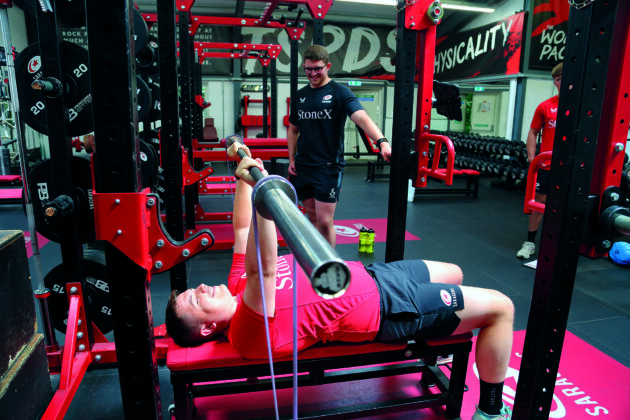
Rugby World editor Joe Robinson lifts a bar (Cara Bowen)
Segun’s score was registered with 60kg of weight on the bar. Our speed comes from when only pushing the bar without any added weight. The gulf between the amateurs and the pros was beginning to show. Between sets, Calder explains that some players, especially through pre-season, can be training up to three times a day. A lower-body session in the morning followed by conditioning and cardio fitness, all concluding with an upper-body session before they head home. In between that will be personal and team analysis work and skill sessions too.
Professional rugby really is a full-time job even through the off-season. “We do Monday, Tuesday, Thursday, Friday in the gym through pre-season, which is eight to ten weeks. That reduces to three days a week when we’re in season, so it stays pretty full-on throughout the year,” says Segun.
“The worst time is when you are injured because you are doing more gym work than those who are fit. You are doing S&C sessions followed by your specific recovery work and it is every day compared to the guys playing who will be getting days off to recover from games.”
Related: Premiership fixtures 25/26
Bracken says: “Some of the younger players, when they are in the academy and being asked to put on size, put on mass; they can be in the gym five to six days a week alongside the usual training on the field. It’s not fun because you are usually sore from the session before and find yourself constantly drinking protein shakes.”
Alongside S&C plans, players will be provided with fuelling strategies that are considered down to the final calorie. Back in the day, much like the gym, ideas around nutrition were fairly basic. With developments in science and the introduction of companies like SiS, this has all changed. Whether it is consumption of creatine prior to workout to help with workout efficiency, electrolytes to rehydrate mid-workout, or protein post-session to support muscle recovery, each player will know exactly what to take in order to maximise performance.
Up next for Josh and I are the counter movement jumps. Segun is the club’s best performing athlete on this particular exercise, achieving a phenomenal static jump height of 62cm, over a third of his height. Josh and I are less impressive, managing 40.1cm and 21.5cm respectively.
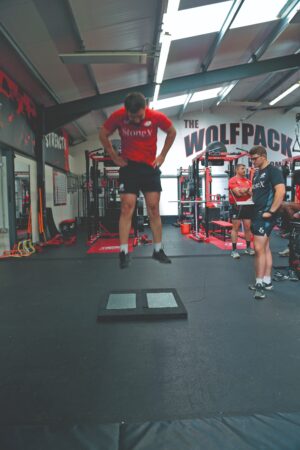
Rugby World deputy edit Josh Graham jumps (Cara Bowen)
Adamant we can get higher, we both start leaping like a pair of mad frogs, which proves a good time for the trio to explain the benefit of resting between sets. “When we are being asked to go after a max effort, I will usually give myself a good two-and-a-half, three minutes between each attempt,” explains Segun. “In fact, I leave that time between sets as a standard.
“I won’t leave that sort of rest for the smaller stuff like bicep curls, where you are after quantity. But for bigger things I will because you want to lift as much as you can for each exercise to get the most from it. A lack of rest and fatigue will impact that most in my experience.”
Related: Best supplements for rugby players
Being able to take two to three minutes between sets goes someway further in showcasing the gap between amateurs and professionals. Usually my gym sessions are squeezed in before the commute to the office or during peak times where other users are prodding me for use of the squat rack.
Ultimately, elite players can dedicate as much time as necessary to getting their strength and conditioning work done. By the sheer size of this gym, we doubt there are many awkward arguments over how many sets someone has left on a particular machine.
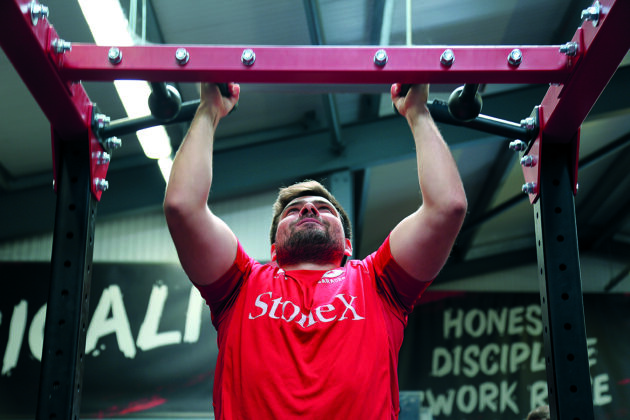
Josh Graham does a chin up (Cara Bowen)
To conclude our humbling session, Calder gets us to complete three weighted chin-ups. Bracken is able to pull 60kg for three, which is 75% of his bodyweight. He admits that this is his ideal exercise but I don’t see Josh and I hitting such numbers.
Josh, though, does manage to complete three pull-ups with a 10kg weight attached to his waist, earning the respect of the onlooking Bracken and Segun. When Segun reaches out to shake Josh’s hand, I can’t help but look on like a proud father. As for me, I fail to register a single bodyweight pull-up. In truth, I don’t even get close. Proof, if any were needed, that us amateur rugby players don’t stand a chance against the professionals.
Test results
Test 1: Dynamic Bench Press – Rotimi Segun 1.40m/s (60kg), Josh 1.58m/s, Joe 1.27m/s
Test 2: Counter Movement Jumps – Rotimi Segun 62cm, Josh 40.1cm, Joe 21.5cm
Test 3: Weighted Chin-Ups – Charlie Bracken 60kg, Josh 10kg, Joe Fail
Download the digital edition of Rugby World straight to your tablet or subscribe to the print edition to get the magazine delivered to your door.
Disclaimer : This story is auto aggregated by a computer programme and has not been created or edited by DOWNTHENEWS. Publisher: rugbyworld.com

